Report: Critique of Quantitative and Qualitative Research Methods
VerifiedAdded on 2021/07/08
|6
|1144
|545
Report
AI Summary
This report provides a comprehensive critique of quantitative and qualitative research methods, focusing on an article examining household food security in Northern Ethiopia. The paper contrasts the two research approaches, highlighting their distinct data collection techniques and research designs. It reviews a qualitative study using interviews and a quantitative study employing a cross-sectional method, both related to the study's central theme. The critique discusses the advantages and disadvantages of each method, emphasizing the role of quantitative data in providing statistical insights and qualitative data in understanding human behaviors. The report also addresses the common debate about the scientific validity of qualitative research, concluding that both methods offer valuable perspectives for research. The conclusion underscores the importance of understanding both quantitative and qualitative research methods for researchers and professionals, especially those in leadership positions, in order to gain a comprehensive understanding of a topic.
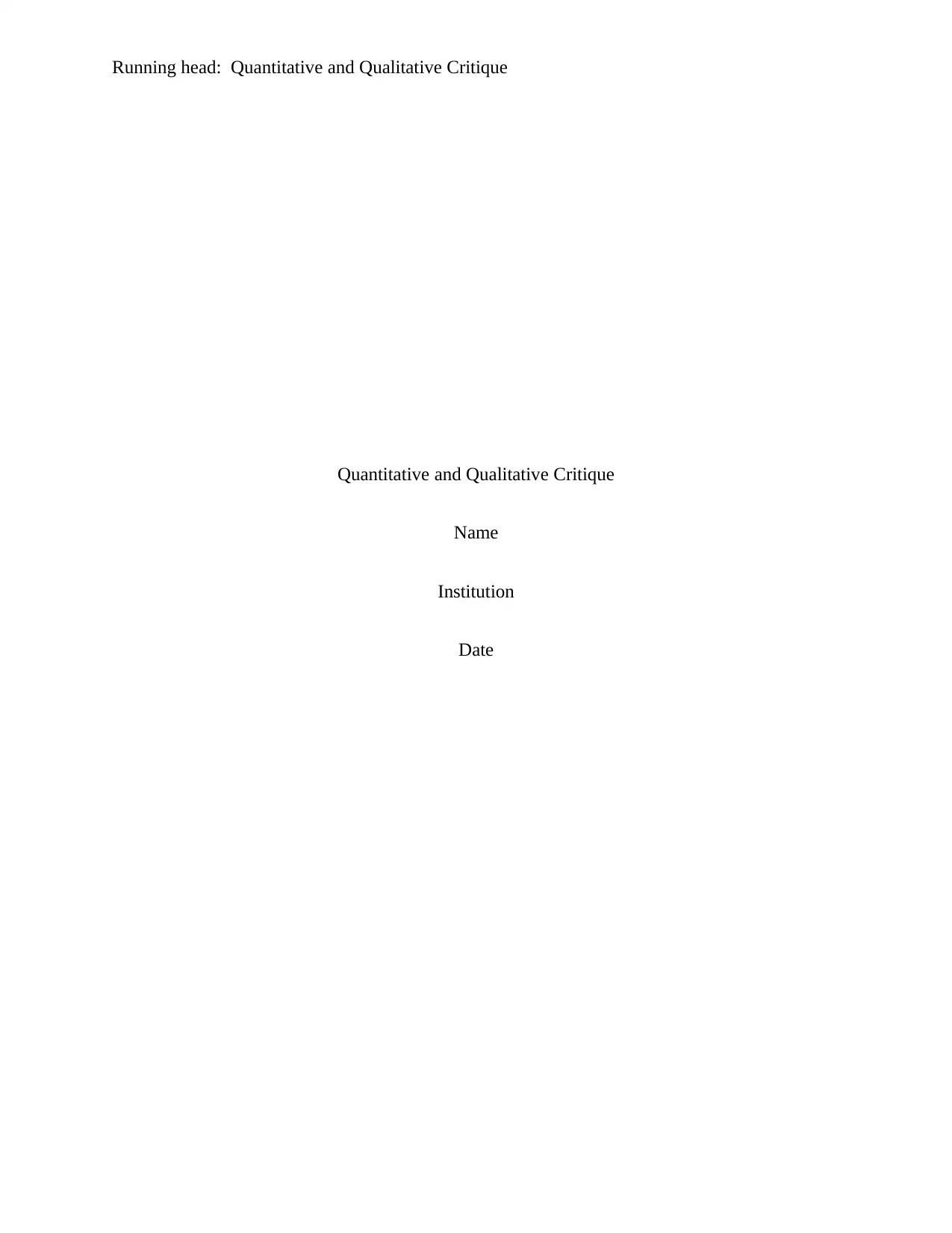
Running head: Quantitative and Qualitative Critique
Quantitative and Qualitative Critique
Name
Institution
Date
Quantitative and Qualitative Critique
Name
Institution
Date
Paraphrase This Document
Need a fresh take? Get an instant paraphrase of this document with our AI Paraphraser
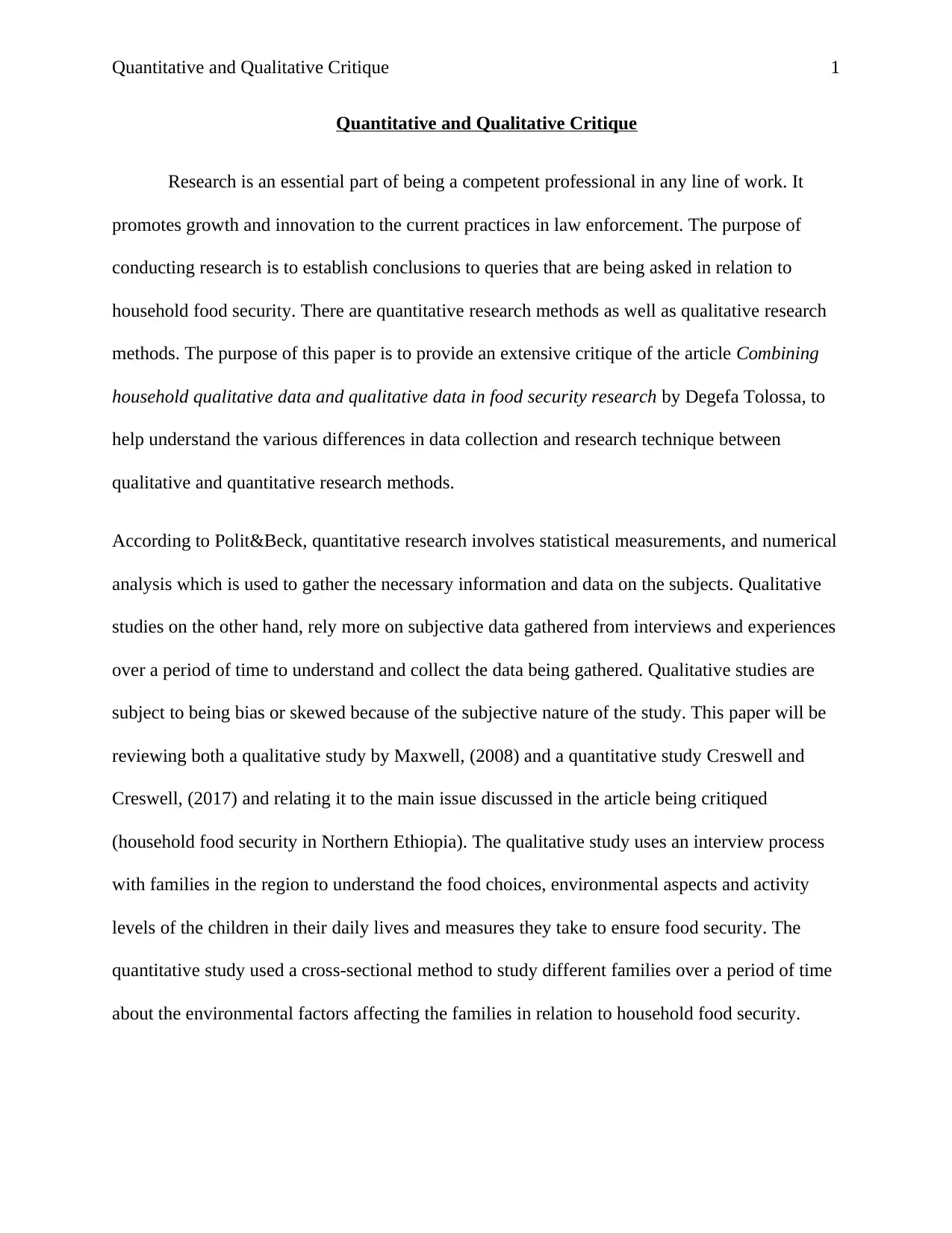
Quantitative and Qualitative Critique 1
Quantitative and Qualitative Critique
Research is an essential part of being a competent professional in any line of work. It
promotes growth and innovation to the current practices in law enforcement. The purpose of
conducting research is to establish conclusions to queries that are being asked in relation to
household food security. There are quantitative research methods as well as qualitative research
methods. The purpose of this paper is to provide an extensive critique of the article Combining
household qualitative data and qualitative data in food security research by Degefa Tolossa, to
help understand the various differences in data collection and research technique between
qualitative and quantitative research methods.
According to Polit&Beck, quantitative research involves statistical measurements, and numerical
analysis which is used to gather the necessary information and data on the subjects. Qualitative
studies on the other hand, rely more on subjective data gathered from interviews and experiences
over a period of time to understand and collect the data being gathered. Qualitative studies are
subject to being bias or skewed because of the subjective nature of the study. This paper will be
reviewing both a qualitative study by Maxwell, (2008) and a quantitative study Creswell and
Creswell, (2017) and relating it to the main issue discussed in the article being critiqued
(household food security in Northern Ethiopia). The qualitative study uses an interview process
with families in the region to understand the food choices, environmental aspects and activity
levels of the children in their daily lives and measures they take to ensure food security. The
quantitative study used a cross-sectional method to study different families over a period of time
about the environmental factors affecting the families in relation to household food security.
Quantitative and Qualitative Critique
Research is an essential part of being a competent professional in any line of work. It
promotes growth and innovation to the current practices in law enforcement. The purpose of
conducting research is to establish conclusions to queries that are being asked in relation to
household food security. There are quantitative research methods as well as qualitative research
methods. The purpose of this paper is to provide an extensive critique of the article Combining
household qualitative data and qualitative data in food security research by Degefa Tolossa, to
help understand the various differences in data collection and research technique between
qualitative and quantitative research methods.
According to Polit&Beck, quantitative research involves statistical measurements, and numerical
analysis which is used to gather the necessary information and data on the subjects. Qualitative
studies on the other hand, rely more on subjective data gathered from interviews and experiences
over a period of time to understand and collect the data being gathered. Qualitative studies are
subject to being bias or skewed because of the subjective nature of the study. This paper will be
reviewing both a qualitative study by Maxwell, (2008) and a quantitative study Creswell and
Creswell, (2017) and relating it to the main issue discussed in the article being critiqued
(household food security in Northern Ethiopia). The qualitative study uses an interview process
with families in the region to understand the food choices, environmental aspects and activity
levels of the children in their daily lives and measures they take to ensure food security. The
quantitative study used a cross-sectional method to study different families over a period of time
about the environmental factors affecting the families in relation to household food security.
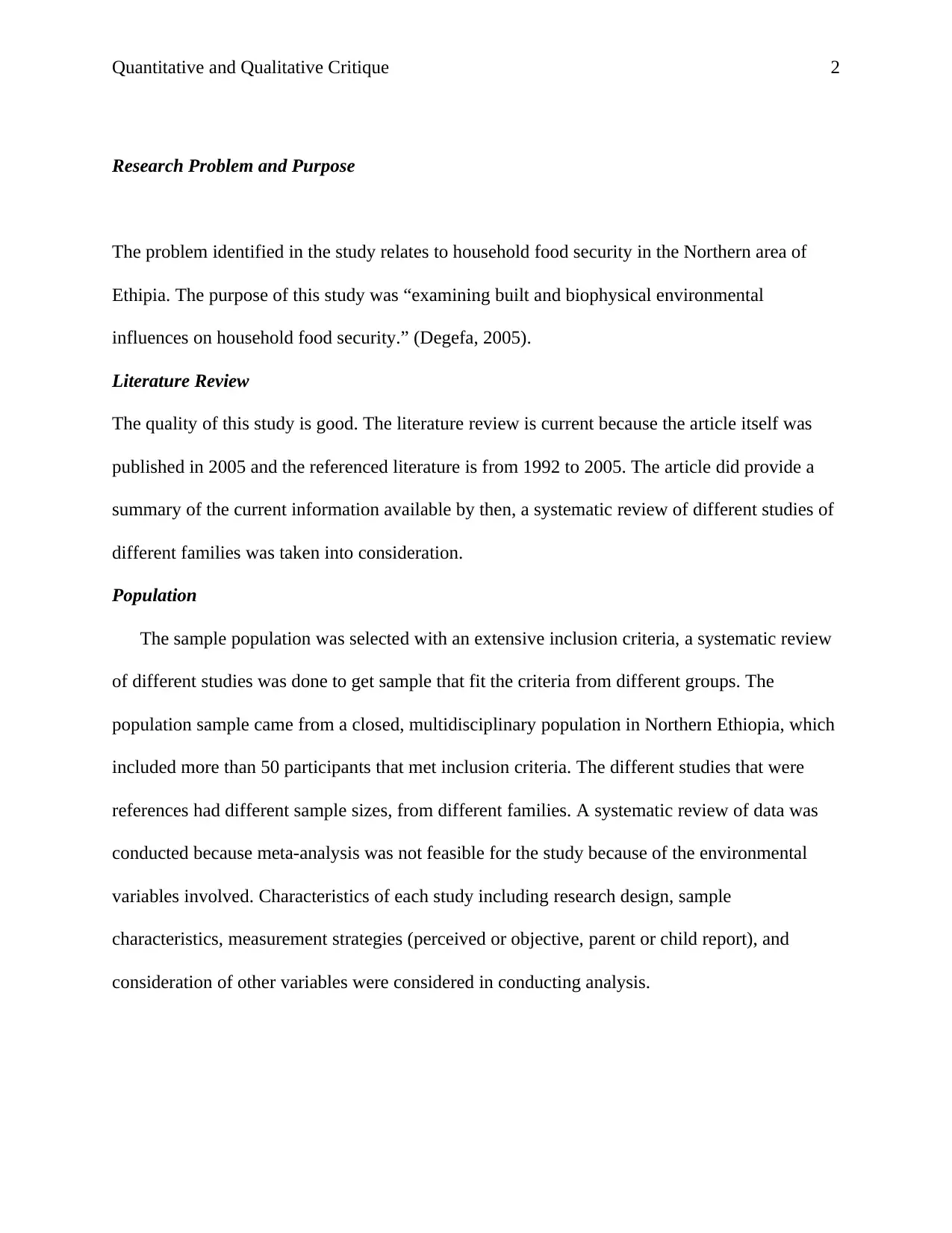
Quantitative and Qualitative Critique 2
Research Problem and Purpose
The problem identified in the study relates to household food security in the Northern area of
Ethipia. The purpose of this study was “examining built and biophysical environmental
influences on household food security.” (Degefa, 2005).
Literature Review
The quality of this study is good. The literature review is current because the article itself was
published in 2005 and the referenced literature is from 1992 to 2005. The article did provide a
summary of the current information available by then, a systematic review of different studies of
different families was taken into consideration.
Population
The sample population was selected with an extensive inclusion criteria, a systematic review
of different studies was done to get sample that fit the criteria from different groups. The
population sample came from a closed, multidisciplinary population in Northern Ethiopia, which
included more than 50 participants that met inclusion criteria. The different studies that were
references had different sample sizes, from different families. A systematic review of data was
conducted because meta-analysis was not feasible for the study because of the environmental
variables involved. Characteristics of each study including research design, sample
characteristics, measurement strategies (perceived or objective, parent or child report), and
consideration of other variables were considered in conducting analysis.
Research Problem and Purpose
The problem identified in the study relates to household food security in the Northern area of
Ethipia. The purpose of this study was “examining built and biophysical environmental
influences on household food security.” (Degefa, 2005).
Literature Review
The quality of this study is good. The literature review is current because the article itself was
published in 2005 and the referenced literature is from 1992 to 2005. The article did provide a
summary of the current information available by then, a systematic review of different studies of
different families was taken into consideration.
Population
The sample population was selected with an extensive inclusion criteria, a systematic review
of different studies was done to get sample that fit the criteria from different groups. The
population sample came from a closed, multidisciplinary population in Northern Ethiopia, which
included more than 50 participants that met inclusion criteria. The different studies that were
references had different sample sizes, from different families. A systematic review of data was
conducted because meta-analysis was not feasible for the study because of the environmental
variables involved. Characteristics of each study including research design, sample
characteristics, measurement strategies (perceived or objective, parent or child report), and
consideration of other variables were considered in conducting analysis.
⊘ This is a preview!⊘
Do you want full access?
Subscribe today to unlock all pages.

Trusted by 1+ million students worldwide
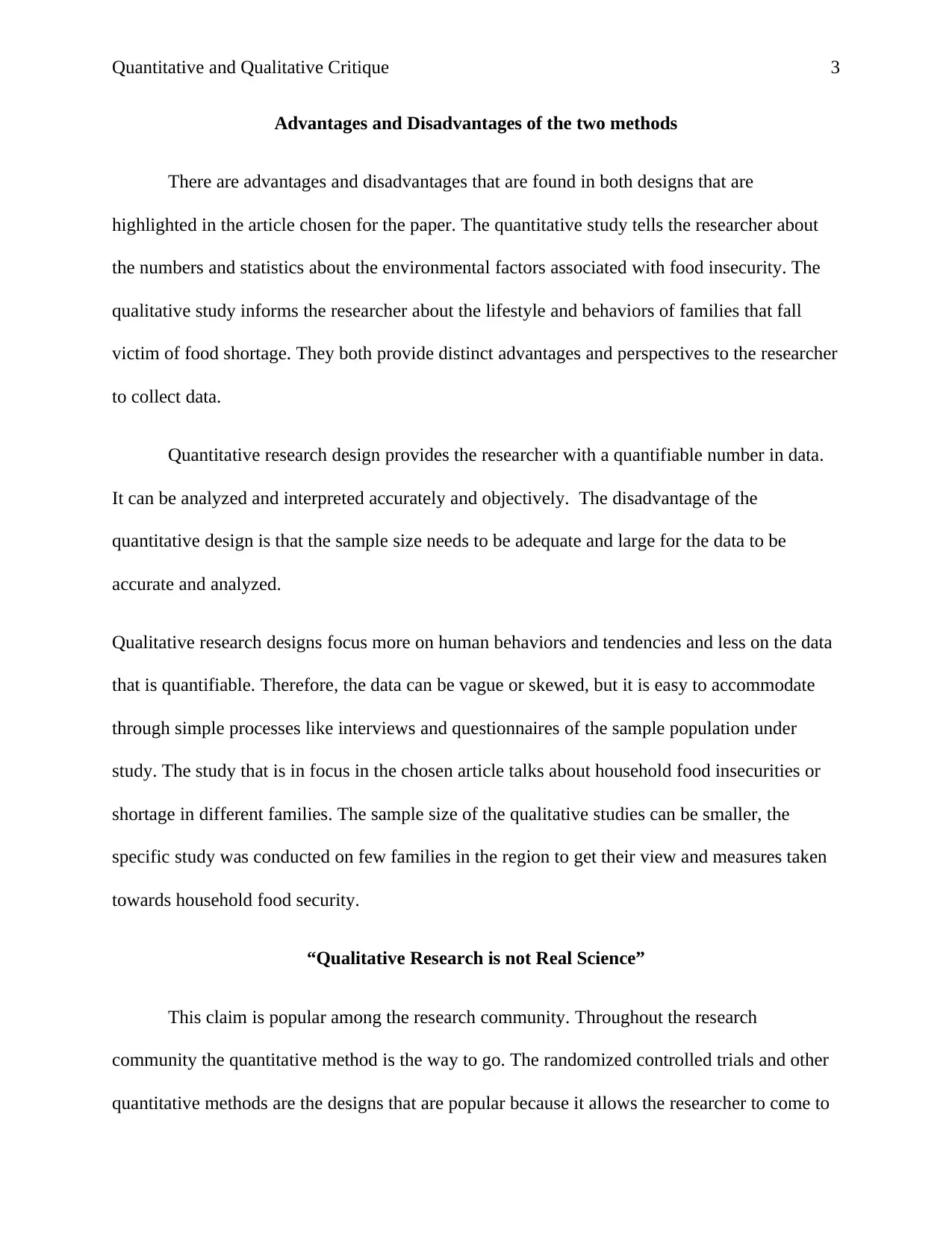
Quantitative and Qualitative Critique 3
Advantages and Disadvantages of the two methods
There are advantages and disadvantages that are found in both designs that are
highlighted in the article chosen for the paper. The quantitative study tells the researcher about
the numbers and statistics about the environmental factors associated with food insecurity. The
qualitative study informs the researcher about the lifestyle and behaviors of families that fall
victim of food shortage. They both provide distinct advantages and perspectives to the researcher
to collect data.
Quantitative research design provides the researcher with a quantifiable number in data.
It can be analyzed and interpreted accurately and objectively. The disadvantage of the
quantitative design is that the sample size needs to be adequate and large for the data to be
accurate and analyzed.
Qualitative research designs focus more on human behaviors and tendencies and less on the data
that is quantifiable. Therefore, the data can be vague or skewed, but it is easy to accommodate
through simple processes like interviews and questionnaires of the sample population under
study. The study that is in focus in the chosen article talks about household food insecurities or
shortage in different families. The sample size of the qualitative studies can be smaller, the
specific study was conducted on few families in the region to get their view and measures taken
towards household food security.
“Qualitative Research is not Real Science”
This claim is popular among the research community. Throughout the research
community the quantitative method is the way to go. The randomized controlled trials and other
quantitative methods are the designs that are popular because it allows the researcher to come to
Advantages and Disadvantages of the two methods
There are advantages and disadvantages that are found in both designs that are
highlighted in the article chosen for the paper. The quantitative study tells the researcher about
the numbers and statistics about the environmental factors associated with food insecurity. The
qualitative study informs the researcher about the lifestyle and behaviors of families that fall
victim of food shortage. They both provide distinct advantages and perspectives to the researcher
to collect data.
Quantitative research design provides the researcher with a quantifiable number in data.
It can be analyzed and interpreted accurately and objectively. The disadvantage of the
quantitative design is that the sample size needs to be adequate and large for the data to be
accurate and analyzed.
Qualitative research designs focus more on human behaviors and tendencies and less on the data
that is quantifiable. Therefore, the data can be vague or skewed, but it is easy to accommodate
through simple processes like interviews and questionnaires of the sample population under
study. The study that is in focus in the chosen article talks about household food insecurities or
shortage in different families. The sample size of the qualitative studies can be smaller, the
specific study was conducted on few families in the region to get their view and measures taken
towards household food security.
“Qualitative Research is not Real Science”
This claim is popular among the research community. Throughout the research
community the quantitative method is the way to go. The randomized controlled trials and other
quantitative methods are the designs that are popular because it allows the researcher to come to
Paraphrase This Document
Need a fresh take? Get an instant paraphrase of this document with our AI Paraphraser
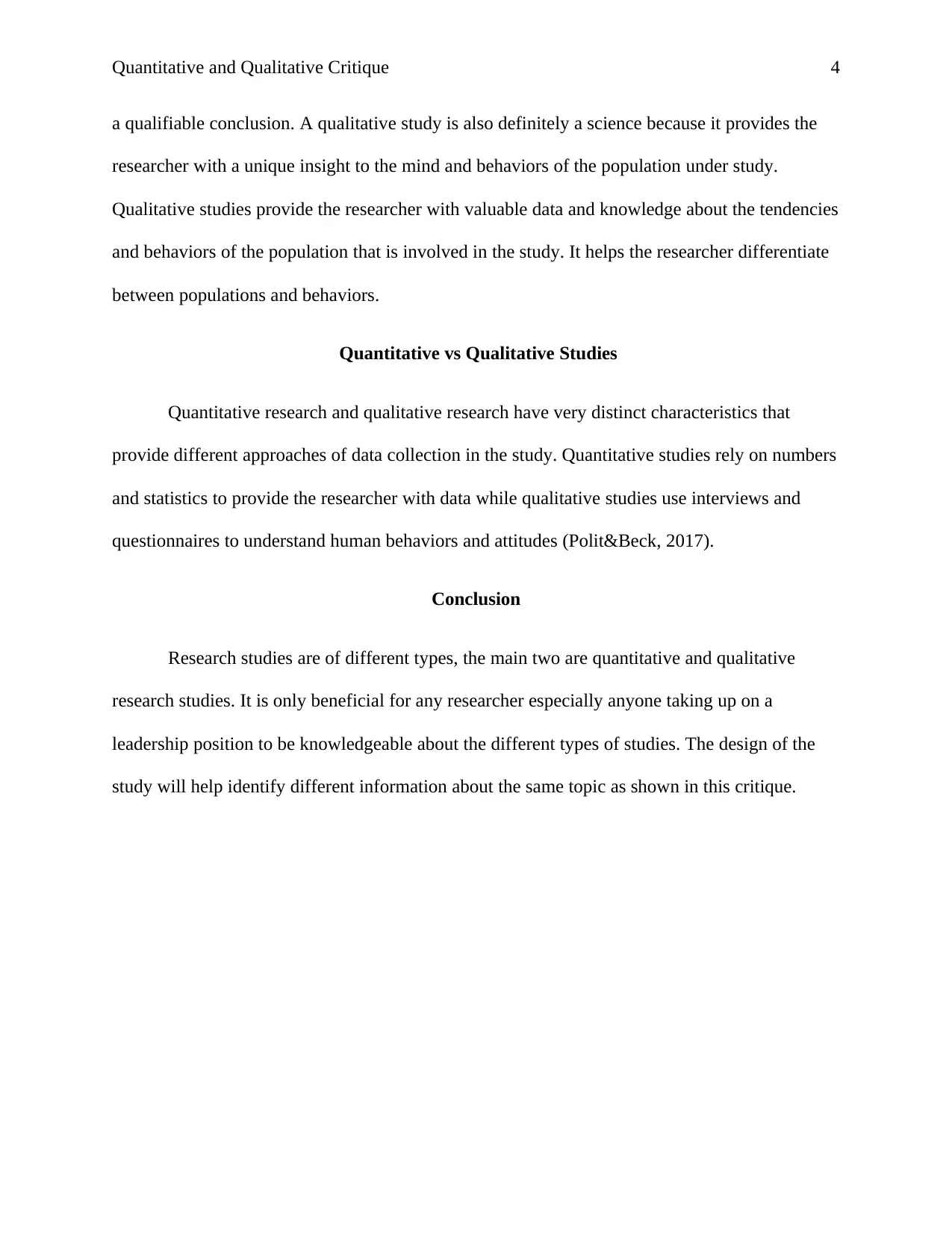
Quantitative and Qualitative Critique 4
a qualifiable conclusion. A qualitative study is also definitely a science because it provides the
researcher with a unique insight to the mind and behaviors of the population under study.
Qualitative studies provide the researcher with valuable data and knowledge about the tendencies
and behaviors of the population that is involved in the study. It helps the researcher differentiate
between populations and behaviors.
Quantitative vs Qualitative Studies
Quantitative research and qualitative research have very distinct characteristics that
provide different approaches of data collection in the study. Quantitative studies rely on numbers
and statistics to provide the researcher with data while qualitative studies use interviews and
questionnaires to understand human behaviors and attitudes (Polit&Beck, 2017).
Conclusion
Research studies are of different types, the main two are quantitative and qualitative
research studies. It is only beneficial for any researcher especially anyone taking up on a
leadership position to be knowledgeable about the different types of studies. The design of the
study will help identify different information about the same topic as shown in this critique.
a qualifiable conclusion. A qualitative study is also definitely a science because it provides the
researcher with a unique insight to the mind and behaviors of the population under study.
Qualitative studies provide the researcher with valuable data and knowledge about the tendencies
and behaviors of the population that is involved in the study. It helps the researcher differentiate
between populations and behaviors.
Quantitative vs Qualitative Studies
Quantitative research and qualitative research have very distinct characteristics that
provide different approaches of data collection in the study. Quantitative studies rely on numbers
and statistics to provide the researcher with data while qualitative studies use interviews and
questionnaires to understand human behaviors and attitudes (Polit&Beck, 2017).
Conclusion
Research studies are of different types, the main two are quantitative and qualitative
research studies. It is only beneficial for any researcher especially anyone taking up on a
leadership position to be knowledgeable about the different types of studies. The design of the
study will help identify different information about the same topic as shown in this critique.
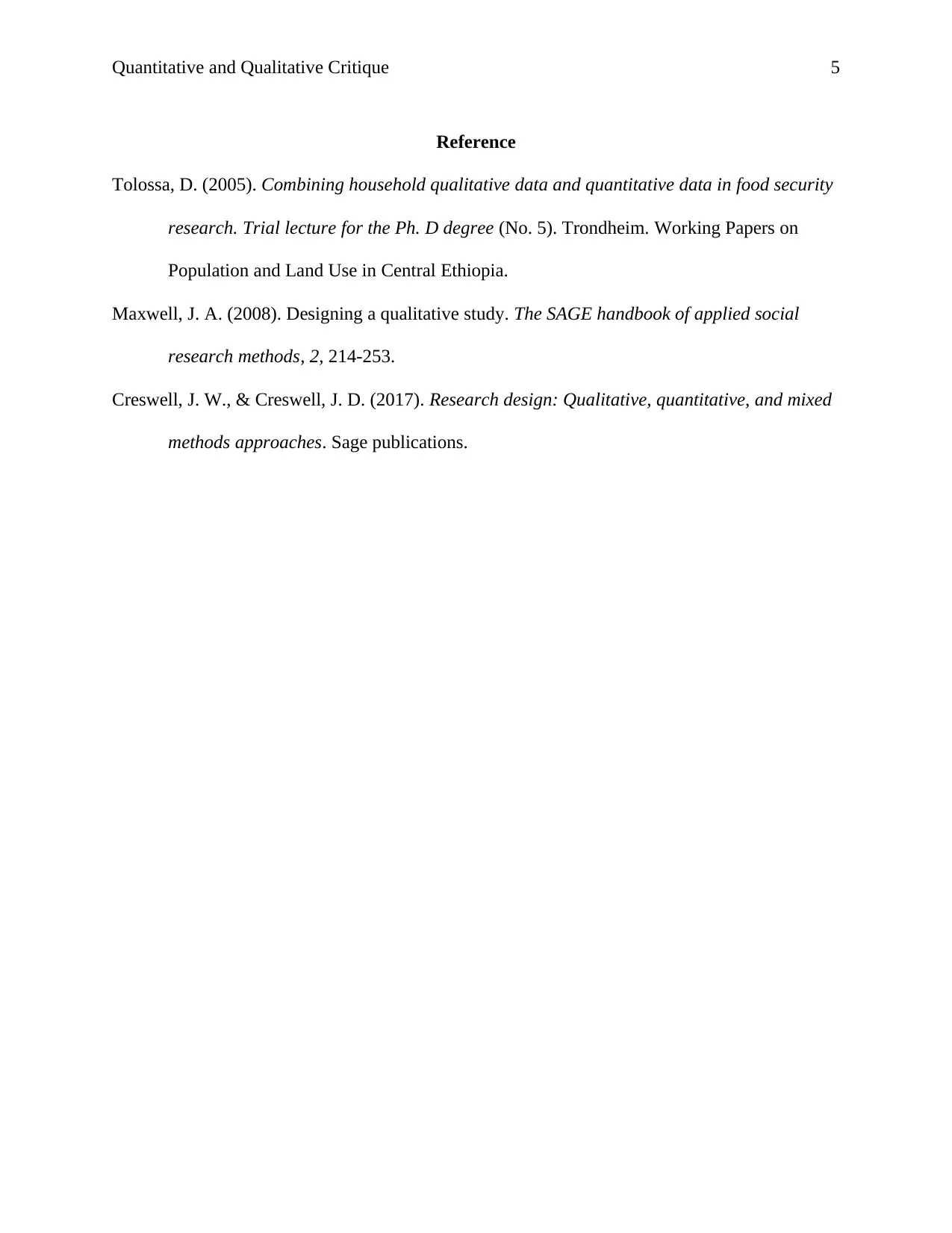
Quantitative and Qualitative Critique 5
Reference
Tolossa, D. (2005). Combining household qualitative data and quantitative data in food security
research. Trial lecture for the Ph. D degree (No. 5). Trondheim. Working Papers on
Population and Land Use in Central Ethiopia.
Maxwell, J. A. (2008). Designing a qualitative study. The SAGE handbook of applied social
research methods, 2, 214-253.
Creswell, J. W., & Creswell, J. D. (2017). Research design: Qualitative, quantitative, and mixed
methods approaches. Sage publications.
Reference
Tolossa, D. (2005). Combining household qualitative data and quantitative data in food security
research. Trial lecture for the Ph. D degree (No. 5). Trondheim. Working Papers on
Population and Land Use in Central Ethiopia.
Maxwell, J. A. (2008). Designing a qualitative study. The SAGE handbook of applied social
research methods, 2, 214-253.
Creswell, J. W., & Creswell, J. D. (2017). Research design: Qualitative, quantitative, and mixed
methods approaches. Sage publications.
⊘ This is a preview!⊘
Do you want full access?
Subscribe today to unlock all pages.

Trusted by 1+ million students worldwide
1 out of 6
Related Documents
Your All-in-One AI-Powered Toolkit for Academic Success.
+13062052269
info@desklib.com
Available 24*7 on WhatsApp / Email
![[object Object]](/_next/static/media/star-bottom.7253800d.svg)
Unlock your academic potential
Copyright © 2020–2025 A2Z Services. All Rights Reserved. Developed and managed by ZUCOL.





